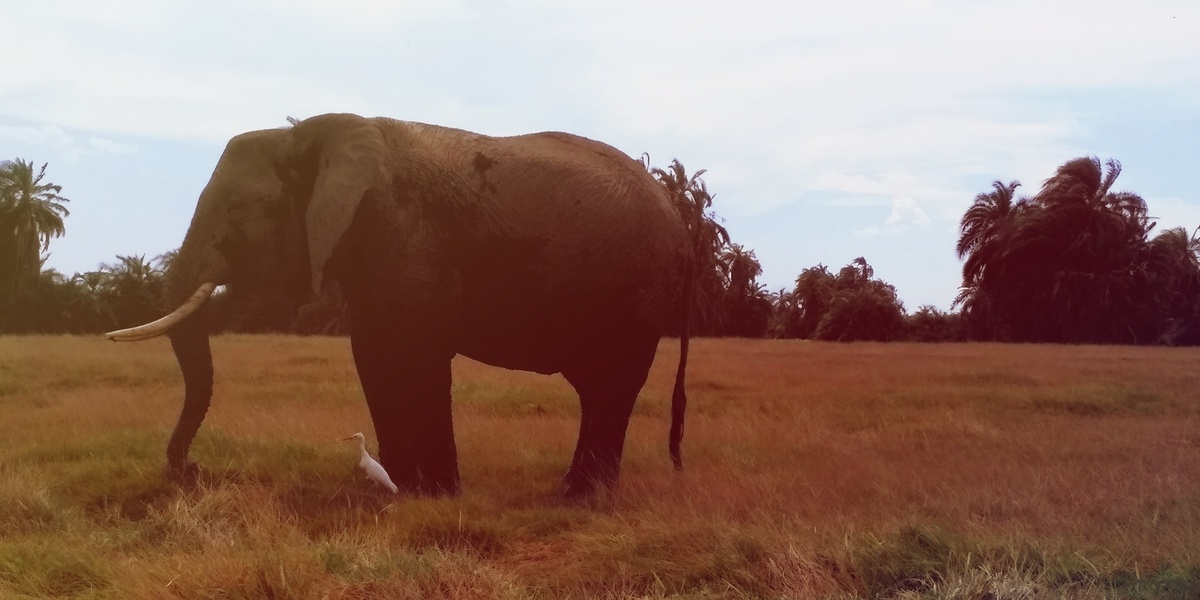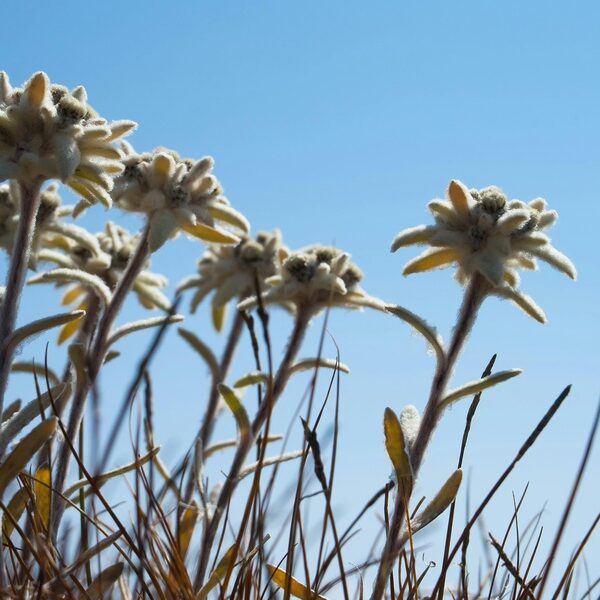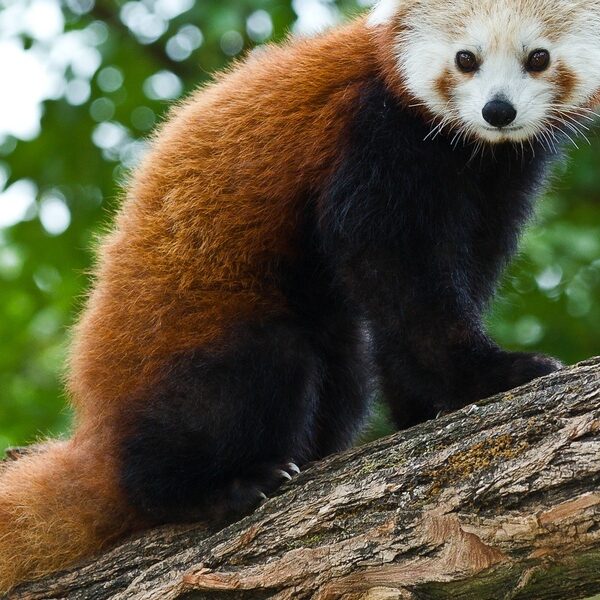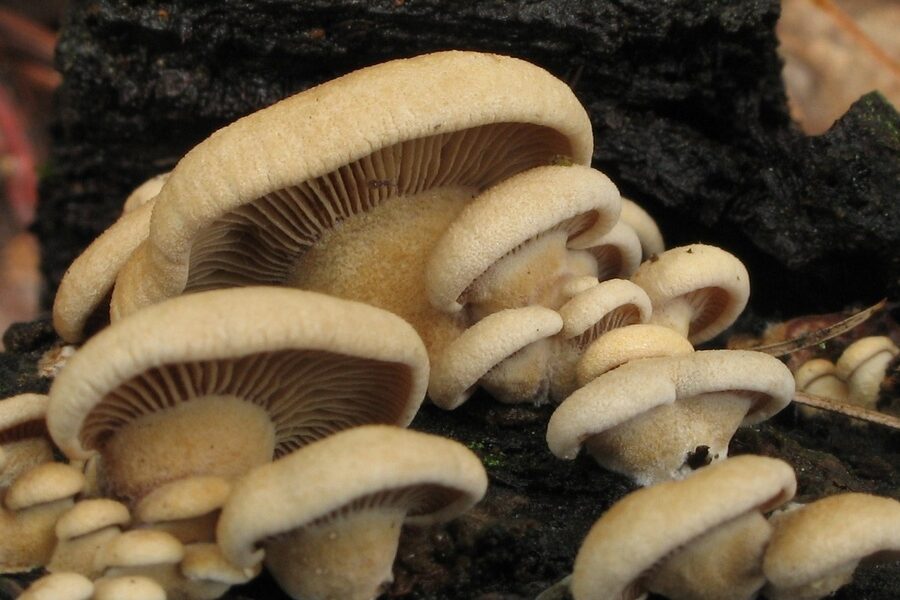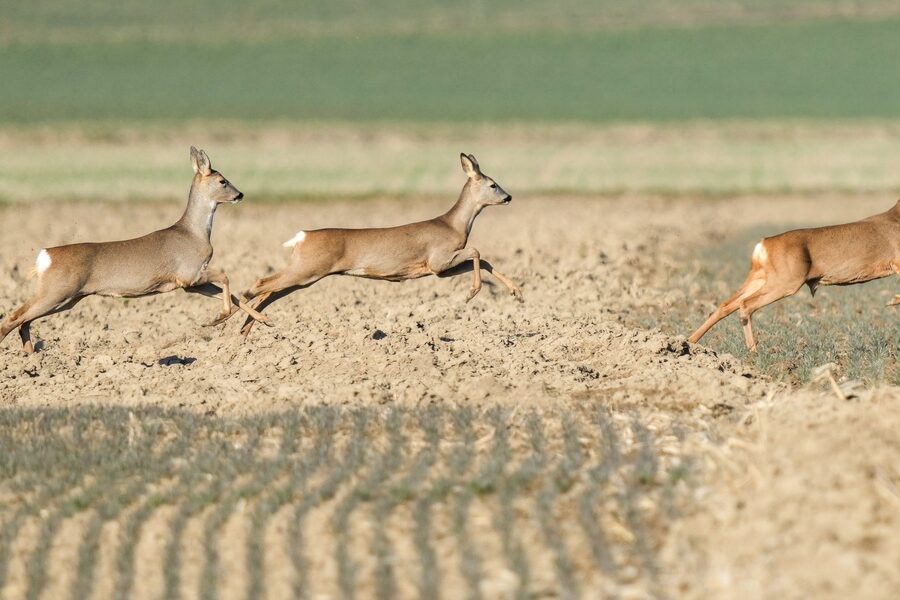West Africa’s landscapes—from Atlantic coastlines and mangroves to savannas and rainforests—host a wide mix of mammals, birds, reptiles and amphibians. Local climates and habitats create distinct pockets of biodiversity that support both widespread species and highly localized ones.
There are 96 Animals of West Africa, ranging from Aardvark to Yellow-fronted Canary. For each species we list Scientific name,Range (countries),IUCN status, all of which you’ll find below.
How up-to-date and complete is this list?
The list aims to be comprehensive for the chosen scope (96 entries) and uses authoritative sources for names and statuses; however, taxonomy and IUCN assessments change periodically. Use the Scientific name to cross-check recent literature or the IUCN Red List for the latest conservation status and range updates.
How can I use the listed columns to find or protect species in the region?
Use Range (countries) to narrow where to look and the Scientific name to avoid common-name confusion; IUCN status helps prioritize conservation attention. For fieldwork or ecotourism, combine this table with local guides, seasonal timing, and protected-area maps to plan sightings or conservation actions.
Animals of West Africa
| Common name | Scientific name | Range (countries) | IUCN status |
|---|---|---|---|
| African Savanna Elephant | Loxodonta africana | Benin;Burkina Faso;Ghana;Guinea;Ivory Coast;Mali;Niger;Nigeria;Senegal;Togo | Endangered |
| African Forest Elephant | Loxodonta cyclotis | Ghana;Guinea;Ivory Coast;Liberia;Nigeria;Sierra Leone | Critically Endangered |
| West African Lion | Panthera leo leo | Benin;Burkina Faso;Niger;Nigeria;Senegal | Critically Endangered |
| Leopard | Panthera pardus | Benin;Burkina Faso;Ghana;Guinea;Ivory Coast;Liberia;Mali;Niger;Nigeria;Senegal;Sierra Leone;Togo | Vulnerable |
| Spotted Hyena | Crocuta crocuta | Benin;Burkina Faso;Ghana;Mali;Niger;Nigeria;Senegal | Least Concern |
| African Wild Dog | Lycaon pictus | Benin;Burkina Faso;Niger;Nigeria;Senegal | Endangered |
| Western Chimpanzee | Pan troglodytes verus | Guinea;Guinea-Bissau;Ivory Coast;Liberia;Mali;Senegal;Sierra Leone | Critically Endangered |
| Pygmy Hippopotamus | Choeropsis liberiensis | Guinea;Ivory Coast;Liberia;Sierra Leone | Endangered |
| Giant Eland | Taurotragus derbianus derbianus | Senegal;Mali;Guinea | Critically Endangered |
| Roan Antelope | Hippotragus equinus | Benin;Burkina Faso;Ghana;Guinea;Ivory Coast;Mali;Niger;Nigeria;Senegal;Togo | Least Concern |
| Kob | Kobus kob | Benin;Burkina Faso;Ghana;Guinea;Ivory Coast;Mali;Niger;Nigeria;Senegal;Togo | Vulnerable |
| West African Giraffe | Giraffa camelopardalis peralta | Niger | Vulnerable |
| African Forest Buffalo | Syncerus caffer nanus | Ghana;Guinea;Ivory Coast;Liberia;Nigeria;Sierra Leone | Near Threatened |
| African Manatee | Trichechus senegalensis | Benin;Gambia;Ghana;Guinea;Guinea-Bissau;Ivory Coast;Liberia;Mali;Mauritania;Niger;Nigeria;Senegal;Sierra Leone;Togo | Vulnerable |
| Giant Pangolin | Smutsia gigantea | Guinea;Ivory Coast;Liberia;Nigeria;Sierra Leone | Endangered |
| White-bellied Pangolin | Phataginus tricuspis | Benin;Ghana;Guinea;Guinea-Bissau;Ivory Coast;Liberia;Nigeria;Senegal;Sierra Leone;Togo | Endangered |
| Aardvark | Orycteropus afer | Widespread across region | Least Concern |
| Serval | Leptailurus serval | Widespread across region | Least Concern |
| Caracal | Caracal caracal | Benin;Burkina Faso;Mali;Mauritania;Niger;Nigeria;Senegal;Togo | Least Concern |
| Patas Monkey | Erythrocebus patas | Benin;Burkina Faso;Gambia;Ghana;Guinea;Guinea-Bissau;Ivory Coast;Mali;Mauritania;Niger;Nigeria;Senegal;Sierra Leone;Togo | Near Threatened |
| Olive Baboon | Papio anubis | Benin;Burkina Faso;Ghana;Guinea;Guinea-Bissau;Ivory Coast;Mali;Niger;Nigeria;Sierra Leone;Togo | Least Concern |
| Sooty Mangabey | Cercocebus atys | Guinea;Guinea-Bissau;Ivory Coast;Liberia;Senegal;Sierra Leone | Vulnerable |
| Upper Guinea Red Colobus | Piliocolobus badius | Ivory Coast;Liberia;Sierra Leone;Guinea | Endangered |
| King Colobus | Colobus polykomos | Gambia;Guinea;Guinea-Bissau;Ivory Coast;Liberia;Senegal;Sierra Leone | Vulnerable |
| Senegal Bushbaby | Galago senegalensis | Benin;Burkina Faso;Gambia;Ghana;Guinea;Guinea-Bissau;Mali;Niger;Nigeria;Senegal;Togo | Least Concern |
| Nile Crocodile | Crocodylus niloticus | Widespread across region | Least Concern |
| West African Slender-snouted Crocodile | Mecistops cataphractus | Benin;Burkina Faso;Ghana;Guinea;Guinea-Bissau;Ivory Coast;Liberia;Nigeria;Senegal;Sierra Leone | Critically Endangered |
| Dwarf Crocodile | Osteolaemus tetraspis | Angola;Benin;Burkina Faso;Cameroon;CAR;Congo;DRC;Equatorial Guinea;Gabon;Gambia;Ghana;Guinea;Guinea-Bissau;Ivory Coast;Liberia;Nigeria;Senegal;Sierra Leone;Togo | Vulnerable |
| Ball Python | Python regius | Benin;Ghana;Guinea;Guinea-Bissau;Ivory Coast;Mali;Niger;Nigeria;Senegal;Sierra Leone;Togo | Near Threatened |
| African Rock Python | Python sebae | Widespread across region | Not Evaluated (as a whole) |
| Gaboon Viper | Bitis gabonica | Guinea;Ivory Coast;Liberia;Nigeria;Sierra Leone;Togo | Near Threatened |
| Western Green Mamba | Dendroaspis viridis | Benin;Gambia;Ghana;Guinea;Guinea-Bissau;Ivory Coast;Liberia;Senegal;Sierra Leone;Togo | Least Concern |
| Nile Monitor | Varanus niloticus | Widespread across region | Least Concern |
| African Spurred Tortoise | Centrochelys sulcata | Burkina Faso;Mali;Mauritania;Niger;Nigeria;Senegal | Endangered |
| Home’s Hinge-back Tortoise | Kinixys homeana | Benin;Ghana;Ivory Coast;Liberia;Nigeria | Vulnerable |
| Green Sea Turtle | Chelonia mydas | Cape Verde;Gambia;Guinea-Bissau;Mauritania;Senegal;Sierra Leone | Endangered |
| Leatherback Sea Turtle | Dermochelys coriacea | Regional coasts | Vulnerable |
| Goliath Frog | Conraua goliath | Equatorial Guinea;Cameroon (range just touches SE Nigeria) | Near Threatened |
| African Bullfrog | Pyxicephalus edulis | Widespread in savannas | Least Concern |
| Grey Parrot | Psittacus erithacus | Ghana;Ivory Coast;Liberia;Nigeria;Sierra Leone | Endangered |
| Timneh Parrot | Psittacus timneh | Guinea;Guinea-Bissau;Ivory Coast;Liberia;Mali;Sierra Leone | Endangered |
| White-necked Rockfowl | Picathartes gymnocephalus | Guinea;Ivory Coast;Liberia;Sierra Leone;Togo;Ghana | Vulnerable |
| Shoebill | Balaeniceps rex | Range extends to Nigeria | Vulnerable |
| Secretarybird | Sagittarius serpentarius | Gambia;Guinea;Mali;Niger;Nigeria;Senegal | Endangered |
| Beaudouin’s Snake Eagle | Circaetus beaudouini | Burkina Faso;Gambia;Guinea;Mali;Niger;Nigeria;Senegal | Vulnerable |
| African Fish Eagle | Haliaeetus vocifer | Widespread near water | Least Concern |
| Yellow-casqued Hornbill | Ceratogymna elata | Gambia;Guinea;Guinea-Bissau;Ivory Coast;Liberia;Mali;Nigeria;Senegal;Sierra Leone;Togo | Vulnerable |
| Standard-winged Nightjar | Caprimulgus longipennis | Benin;Burkina Faso;Ghana;Guinea;Ivory Coast;Liberia;Mali;Nigeria;Senegal;Sierra Leone;Togo | Least Concern |
| Abyssinian Roller | Coracias abyssinicus | Benin;Burkina Faso;Gambia;Ghana;Guinea;Ivory Coast;Mali;Mauritania;Niger;Nigeria;Senegal;Togo | Least Concern |
| Egyptian Plover | Pluvianus aegyptius | Benin;Burkina Faso;Ghana;Mali;Niger;Nigeria;Senegal | Least Concern |
| Violet Turaco | Musophaga violacea | Benin;Burkina Faso;Gambia;Ghana;Guinea;Ivory Coast;Mali;Niger;Nigeria;Senegal;Togo | Least Concern |
| Ibadan Malimbe | Malimbus ibadanensis | Nigeria | Endangered |
| Goliath Tigerfish | Hydrocynus goliath | Nigeria (Benue River); Niger River | Least Concern |
| Nile Perch | Lates niloticus | Benin;Burkina Faso;Ghana;Guinea;Mali;Niger;Nigeria;Senegal;Togo | Least Concern |
| African Arowana | Heterotis niloticus | Benin;Burkina Faso;Gambia;Ghana;Guinea;Guinea-Bissau;Mali;Niger;Nigeria;Senegal;Togo | Least Concern |
| West African Lungfish | Protopterus annectens | Widespread in region | Least Concern |
| Goliath Beetle | Goliathus goliatus | Ghana;Ivory Coast;Nigeria | Not Evaluated |
| Driver Ants | Dorylus spp. | Widespread in region | Not Evaluated |
| African Giant Millipede | Archispirostreptus gigas | Widespread in region | Not Evaluated |
| Common Agama Lizard | Agama agama | Widespread in region | Not Evaluated |
| Warthog | Phacochoerus africanus | Widespread in savannas | Least Concern |
| Crested Porcupine | Hystrix cristata | Benin;Burkina Faso;Ghana;Liberia;Mali;Mauritania;Niger;Nigeria;Senegal;Sierra Leone;Togo | Least Concern |
| Hippopotamus | Hippopotamus amphibius | Benin;Burkina Faso;Gambia;Ghana;Guinea;Guinea-Bissau;Ivory Coast;Mali;Niger;Nigeria;Senegal;Sierra Leone | Vulnerable |
| Gambian Pouched Rat | Cricetomys gambianus | Widespread in region | Least Concern |
| Hooded Vulture | Necrosyrtes monachus | Widespread in region | Critically Endangered |
| Palm-nut Vulture | Gypohierax angolensis | Widespread in region | Least Concern |
| African Grey Hornbill | Lophoceros nasutus | Widespread in region | Least Concern |
| Red-billed Hornbill | Tockus erythrorhynchus | Benin;Burkina Faso;Gambia;Ghana;Mali;Mauritania;Niger;Nigeria;Senegal | Least Concern |
| Lilac-breasted Roller | Coracias caudatus | Range extends into Nigeria | Least Concern |
| Red-throated Bee-eater | Merops bulocki | Benin;Burkina Faso;Gambia;Ghana;Guinea;Mali;Niger;Nigeria;Senegal;Togo | Least Concern |
| Village Weaver | Ploceus cucullatus | Widespread in region | Least Concern |
| Splendid Sunbird | Cinnyris coccinigastrus | Benin;Gambia;Ghana;Guinea;Guinea-Bissau;Ivory Coast;Liberia;Mali;Nigeria;Senegal;Sierra Leone;Togo | Least Concern |
| Marsh Mongoose | Atilax paludinosus | Benin;Ghana;Guinea;Guinea-Bissau;Ivory Coast;Liberia;Nigeria;Senegal;Sierra Leone;Togo | Least Concern |
| Maxwell’s Duiker | Philantomba maxwellii | Benin;Gambia;Ghana;Guinea;Guinea-Bissau;Ivory Coast;Liberia;Nigeria;Senegal;Sierra Leone;Togo | Least Concern |
| Bushbuck | Tragelaphus scriptus | Widespread in region | Least Concern |
| Green Bush Viper | Atheris squamigera | Ghana;Togo;Nigeria | Least Concern |
| Royal Antelope | Neotragus pygmaeus | Ghana;Guinea;Ivory Coast;Liberia;Sierra Leone | Least Concern |
| African Civet | Civettictis civetta | Widespread in region | Least Concern |
| Senegal Chameleon | Chamaeleo senegalensis | Benin;Burkina Faso;Gambia;Ghana;Guinea;Guinea-Bissau;Ivory Coast;Mali;Nigeria;Senegal;Togo | Least Concern |
| Striped Jackal | Lupulella adusta | Burkina Faso;Ghana;Guinea;Ivory Coast;Liberia;Mali;Niger;Nigeria;Senegal;Sierra Leone | Least Concern |
| Yellow-backed Duiker | Cephalophus silvicultor | Benin;Ghana;Guinea;Guinea-Bissau;Ivory Coast;Liberia;Nigeria;Senegal;Sierra Leone;Togo | Near Threatened |
| Black Crowned Crane | Balearica pavonina | Gambia;Guinea;Mali;Niger;Nigeria;Senegal | Vulnerable |
| Piapiac | Ptilostomus afer | Benin;Burkina Faso;Gambia;Ghana;Guinea;Mali;Niger;Nigeria;Senegal | Least Concern |
| Blue-bellied Roller | Coracias cyanogaster | Benin;Gambia;Ghana;Guinea;Guinea-Bissau;Ivory Coast;Mali;Nigeria;Senegal;Sierra Leone | Least Concern |
| African Finfoot | Podica senegalensis | Widespread in region | Least Concern |
| Gemsbok | Oryx gazella | Range extends into Niger and Mali | Least Concern |
| Addax | Addax nasomaculatus | Mauritania;Niger | Critically Endangered |
| Dama Gazelle | Nanger dama | Mali;Niger | Critically Endangered |
| Aardwolf | Proteles cristatus | Range extends into southern Sahel | Least Concern |
| Cheetah | Acinonyx jubatus | Benin;Burkina Faso;Mali;Niger | Vulnerable |
| Bongo | Tragelaphus eurycerus | Sierra Leone;Liberia;Ivory Coast;Ghana | Near Threatened |
| Four-toed Sengi | Petrodromus tetradactylus | Range extends into Nigeria | Least Concern |
| Long-tailed Glossy Starling | Lamprotornis caudatus | Gambia;Guinea;Guinea-Bissau;Ivory Coast;Mali;Mauritania;Niger;Nigeria;Senegal | Least Concern |
| Hammerkop | Scopus umbretta | Widespread in region | Least Concern |
| Senegal Parrot | Poicephalus senegalus | Benin;Burkina Faso;Gambia;Ghana;Guinea;Guinea-Bissau;Ivory Coast;Mali;Mauritania;Niger;Nigeria;Senegal;Togo | Least Concern |
| Yellow-fronted Canary | Crithagra mozambica | Widespread in savannas | Least Concern |
Images and Descriptions
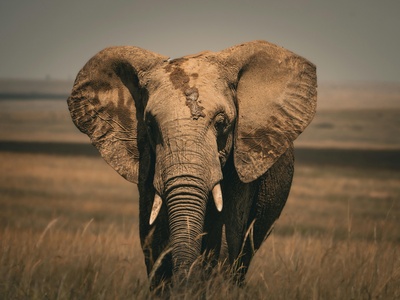
African Savanna Elephant
The world’s largest land animal, this elephant inhabits savannas and woodlands. It is a keystone species, crucial for shaping its environment. Major populations are found in the W-Arly-Pendjari Complex and Mole National Park in Ghana.
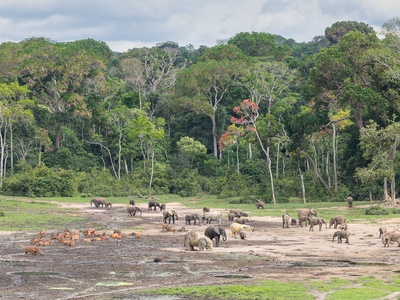
African Forest Elephant
Smaller than its savanna cousin, with straighter tusks and rounded ears, this elusive elephant lives in dense rainforests. It is a vital forest gardener, dispersing seeds over large distances. It is found in Taï National Park and Cross River National Park.
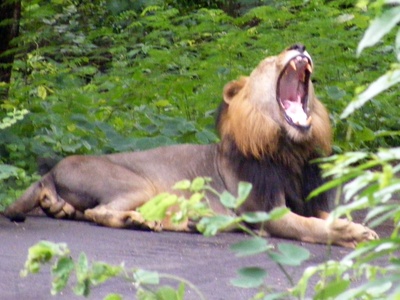
West African Lion
A genetically distinct and highly endangered lion subspecies. Fewer than 400 individuals remain, primarily in the W-Arly-Pendjari Complex and Senegal’s Niokolo-Koba National Park. They are typically smaller and have smaller manes than other lions.
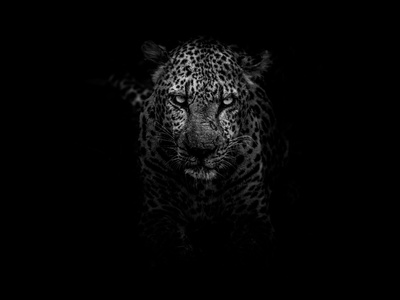
Leopard
This adaptable and powerful big cat is found across various habitats, from rainforests to arid regions. It is a solitary, nocturnal hunter known for its rosette-patterned coat and ability to climb trees. Sightings are rare due to its secretive nature.
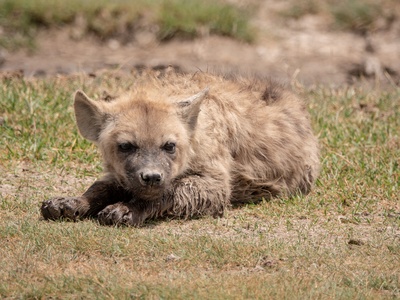
Spotted Hyena
A highly intelligent and social carnivore with a powerful bite. Often miscast as a scavenger, it is a formidable hunter. Found in savannas and grasslands, with strongholds in parks like Mole (Ghana) and Niokolo-Koba (Senegal).
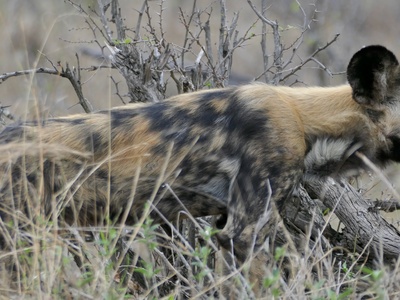
African Wild Dog
Also called the painted dog, this highly social canid is known for its large, round ears and patterned coat. They are cooperative hunters that roam vast territories in savanna and woodland. West African populations are critically fragmented and small.
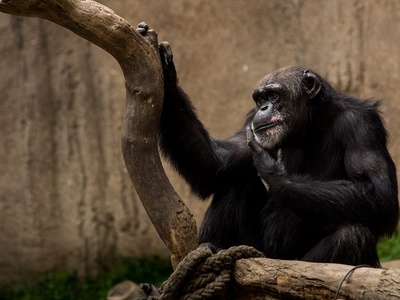
Western Chimpanzee
Our closest living relative, known for complex social structures and tool use. They inhabit forests and woodlands. Significant populations exist in the Fouta Djallon highlands of Guinea and Taï National Park in Ivory Coast.
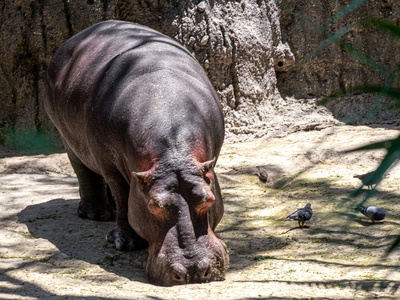
Pygmy Hippopotamus
A much smaller, solitary, and nocturnal version of the common hippo. It is largely terrestrial, seeking refuge in forests and swamps. Found almost exclusively in the Upper Guinea forests, with Sapo National Park in Liberia being a key stronghold.
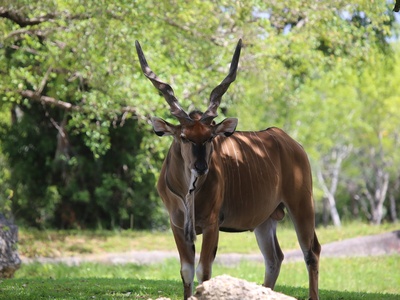
Giant Eland
The largest antelope species, with magnificent spiral horns. The Western subspecies is critically endangered, with the last viable population found almost exclusively in Senegal’s Niokolo-Koba National Park. It prefers savanna woodlands.
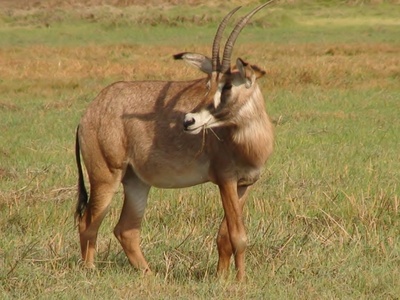
Roan Antelope
A large, horse-like antelope with long, tufted ears and backward-curving horns. It lives in small herds in grasslands and savanna woodlands. Good places to spot them include Mole National Park (Ghana) and Comoé National Park (Ivory Coast).
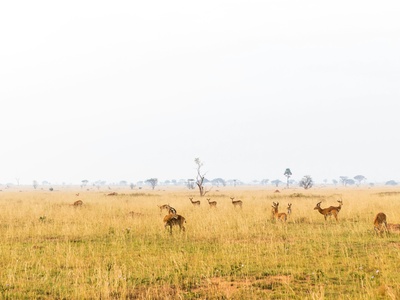
Kob
A medium-sized, graceful antelope found near water in savannas. Males are known for their lyre-shaped horns and for forming “leks” or breeding arenas to attract females. Commonly seen in many West African national parks.
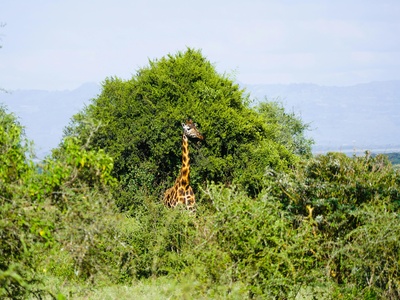
West African Giraffe
Also known as the Nigerien giraffe, this is the last remaining population of this subspecies. Once widespread, they now live in a small region east of Niamey, Niger, coexisting with local villagers. Conservation efforts have helped their numbers rebound.
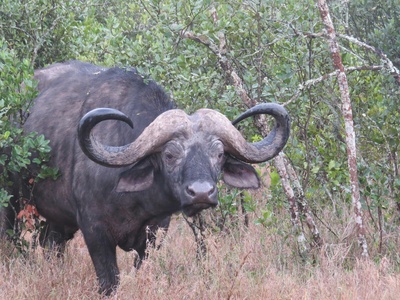
African Forest Buffalo
A smaller, reddish-brown subspecies of the African buffalo adapted to dense forest and swamp habitats. They have smaller, upward-curving horns compared to their savanna counterparts. Found in parks like Taï (Ivory Coast) and Korup (on the Nigeria-Cameroon border).
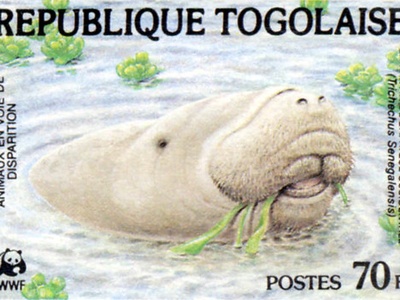
African Manatee
A large, slow-moving aquatic mammal found in coastal waters, estuaries, rivers, and lakes. This gentle herbivore is threatened by hunting and habitat degradation. Sightings are possible in the Saloum Delta (Senegal) and the lower Volta River (Ghana).
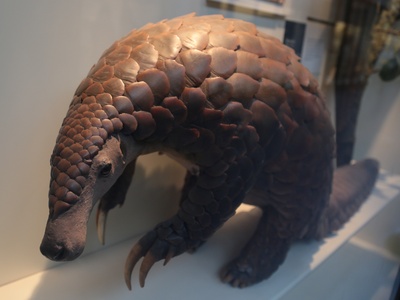
Giant Pangolin
The largest of the pangolin species, this nocturnal, ant-eating mammal is covered in tough keratin scales. It inhabits forests and savannas but is rarely seen. It is severely threatened by illegal trafficking for its scales and meat.
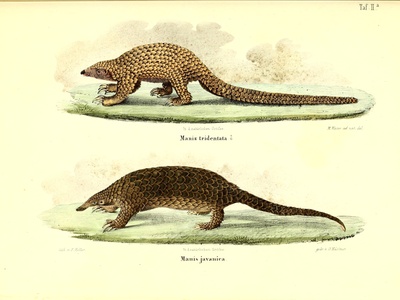
White-bellied Pangolin
A smaller, arboreal pangolin that uses its prehensile tail to climb trees in search of ants and termites. It is found in the forest zones and is one of the most trafficked mammals in the world due to high demand in Asia.
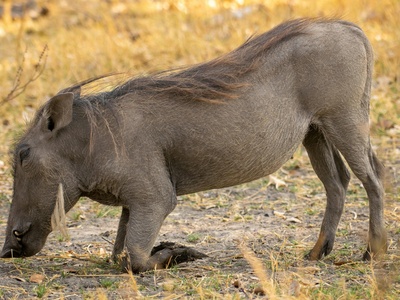
Aardvark
A unique nocturnal mammal with a pig-like snout, rabbit-like ears, and powerful claws for digging. It feeds almost exclusively on ants and termites, and its abandoned burrows provide shelter for many other species. Rarely seen due to its habits.
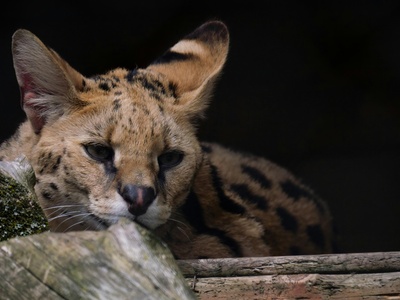
Serval
A slender, medium-sized wild cat with long legs, a short tail, and large ears. It is an expert pouncer, hunting small animals in tall grasslands and wetlands. It can leap over 2 meters high to catch birds in mid-air.
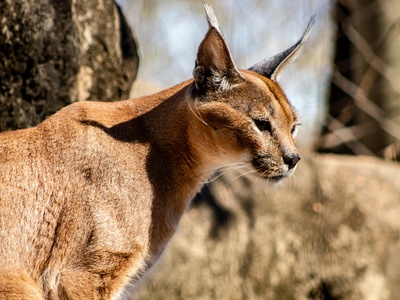
Caracal
A graceful, medium-sized cat known for its reddish coat and long, black-tufted ears. It is an incredible jumper and can catch birds in flight. It inhabits savannas, woodlands, and semi-deserts, preying on birds and small mammals.
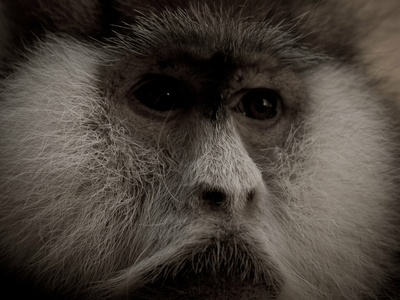
Patas Monkey
A lanky, ground-dwelling monkey built for speed, often called the “cheetah” of the primate world. It lives in large troops in open savanna and can run up to 55 km/h to escape predators.
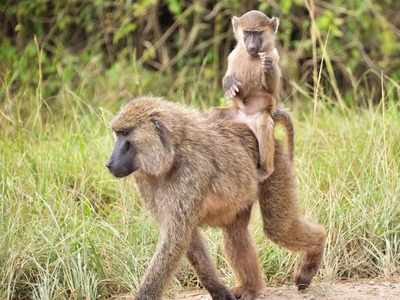
Olive Baboon
A highly adaptable and widespread baboon species. They live in large, complex social troops in savannas, grasslands, and forests. Their omnivorous diet and intelligence allow them to thrive in many environments, sometimes close to human settlements.
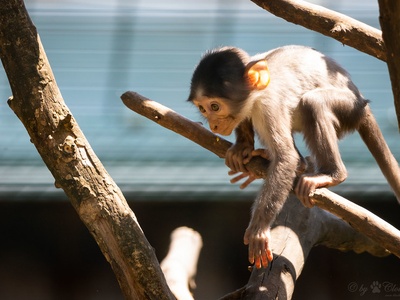
Sooty Mangabey
A large, grey monkey with distinctive white eyelids, which they flash as a communication signal. They are primarily ground-dwelling and live in large groups in the forests of the Upper Guinea region, such as Taï National Park.
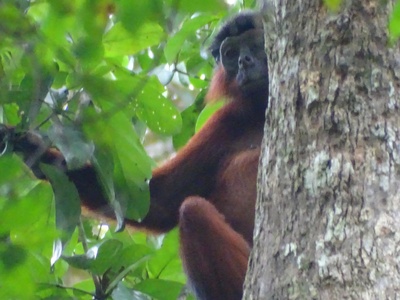
Upper Guinea Red Colobus
A colorful monkey with a black back, red-brown limbs, and a pale underside. It lives in large, multi-male, multi-female groups in the primary rainforests of the Upper Guinea block. They are specialist leaf-eaters.
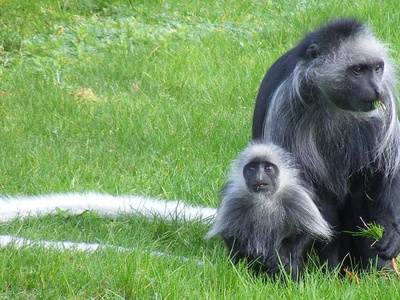
King Colobus
A striking black monkey with a long, flowing white mantle of hair, a white beard, and a bushy white tail. It is an arboreal leaf-eater found in the canopy of rainforests.
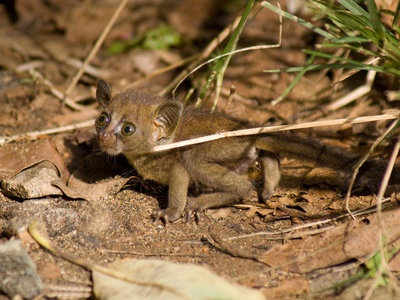
Senegal Bushbaby
A small, nocturnal primate with large eyes and ears, and a long tail for balance. It is an agile leaper, feeding on insects and tree gum in dry woodlands and savannas. Its loud, baby-like cry is often heard at night.
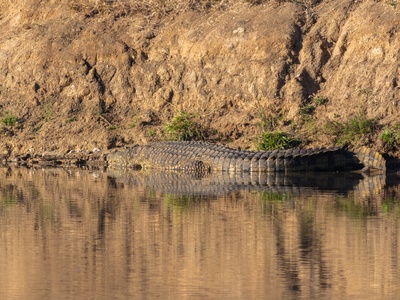
Nile Crocodile
Africa’s largest crocodilian, a formidable apex predator found in rivers, lakes, and marshes. They are opportunistic hunters, capable of taking down large prey like antelope. Can be seen in places like the Gambia River and Mole National Park.
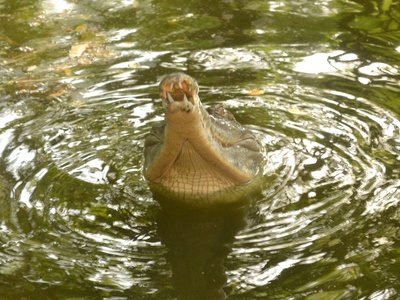
West African Slender-snouted Crocodile
Distinguished by its very long, slender snout, this crocodile is adapted for catching fish. It lives in forested rivers and coastal lagoons. This shy species is under extreme threat from habitat loss and hunting.
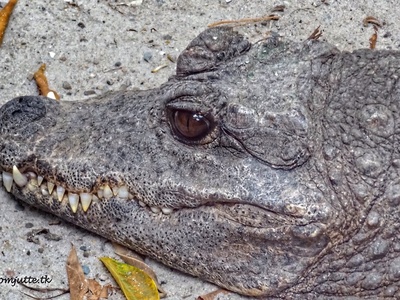
Dwarf Crocodile
The world’s smallest crocodile, rarely exceeding 1.5 meters in length. It is a shy, nocturnal reptile that prefers slow-moving water in rainforests and swamps. It spends much of the day hidden in burrows.
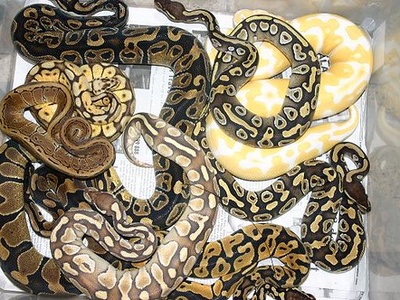
Ball Python
A small, non-venomous constrictor known for its docile temperament and tendency to curl into a tight ball when threatened. It inhabits grasslands and open forests and is one of the most popular snakes in the global pet trade.
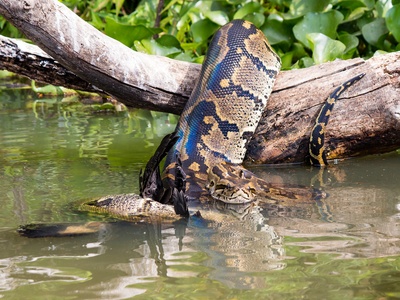
African Rock Python
Africa’s largest snake, a powerful constrictor that can reach lengths over 6 meters. It is found in a variety of habitats, usually near water, where it ambushes prey as large as small antelopes or crocodiles.
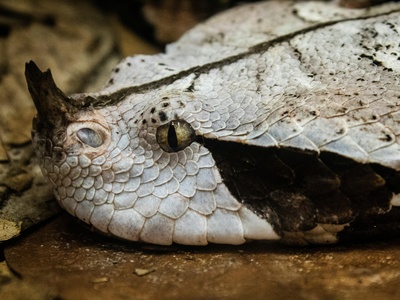
Gaboon Viper
A heavy-bodied, venomous viper with the longest fangs of any snake (up to 5 cm) and a very high venom yield. Its geometric pattern provides excellent camouflage on the forest floor of rainforests and woodlands.
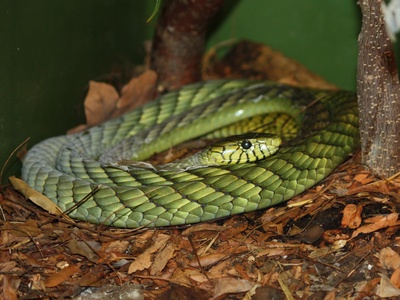
Western Green Mamba
A highly venomous but slender and graceful arboreal snake. It has a vivid green color that provides camouflage in the forest canopy where it hunts birds and small mammals. Despite its venom, it is generally not aggressive.
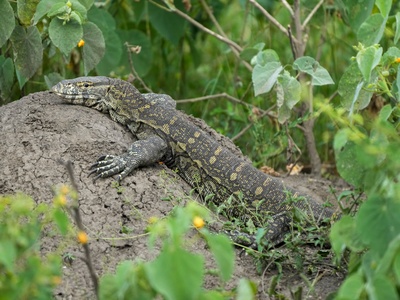
Nile Monitor
A large, powerful lizard that can grow over 2 meters long. It is a highly active predator and scavenger, found in and around rivers and wetlands. It is an excellent swimmer and can climb and run with surprising speed.
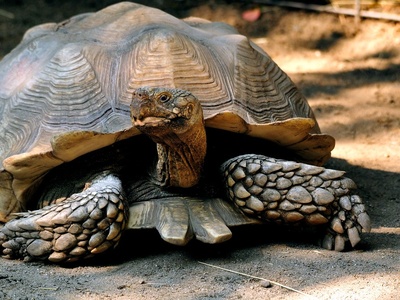
African Spurred Tortoise
The largest mainland tortoise species in the world, found along the southern edge of the Sahara desert (the Sahel). It is known for its ability to dig long burrows to escape the heat and is threatened by desertification and collection.
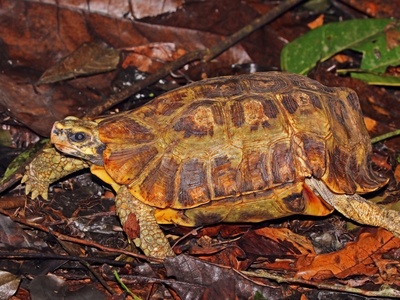
Home’s Hinge-back Tortoise
A forest tortoise with a unique hinge on the back of its shell, allowing it to close down to protect its hind legs and tail from predators. It is found in the humid forest belt and is threatened by habitat loss and hunting.
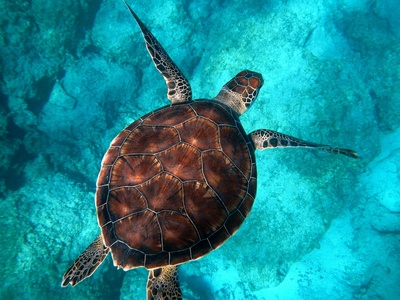
Green Sea Turtle
This large sea turtle nests on West African beaches, particularly in Guinea-Bissau’s Bijagós Archipelago, which is one of the most important nesting sites in the Atlantic. They migrate vast distances to feed on seagrass.
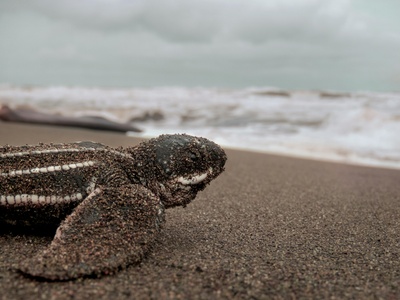
Leatherback Sea Turtle
The largest of all living turtles, distinguished by its lack of a bony shell, having a leathery skin instead. It is a deep-diving specialist that travels the world’s oceans. West African coastlines provide important nesting grounds.
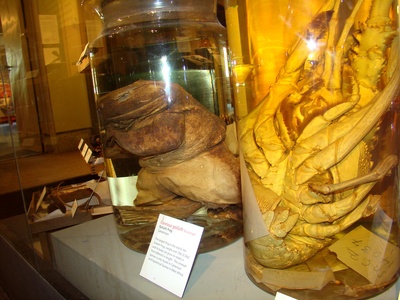
Goliath Frog
The largest living frog in the world, capable of growing up to 32 cm long and weighing over 3 kg. It lives in and near fast-flowing, oxygen-rich rivers in dense rainforests. Its range barely extends into southeastern Nigeria.
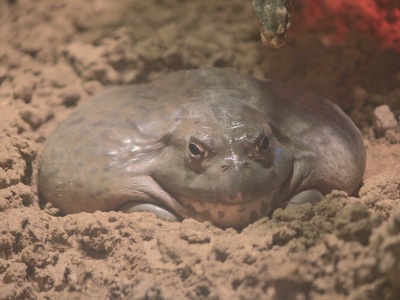
African Bullfrog
A very large and aggressive frog, with males developing tooth-like projections on their lower jaw. They spend most of the year dormant underground, emerging with the rains to breed in temporary pools.
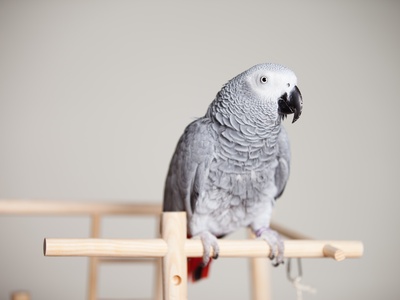
Grey Parrot
Highly intelligent and famous for its ability to mimic human speech. Its plumage is a subtle grey with a striking red tail. Wild populations have been devastated by the pet trade and deforestation in the forests of Central and West Africa.
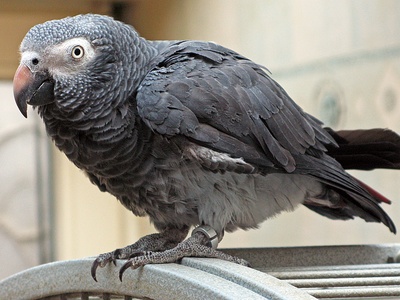
Timneh Parrot
Slightly smaller and darker than the Grey Parrot, with a maroon tail. Formerly a subspecies, it is now recognized as a full species. It is also highly intelligent and faces severe threats from trapping for the pet trade.
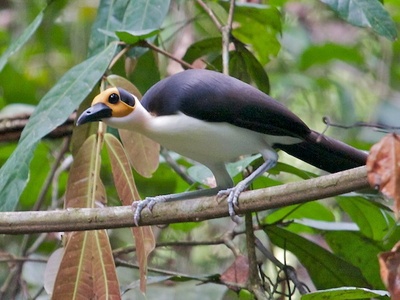
White-necked Rockfowl
A bizarre and unique bird with a bare, brightly-colored yellow and black head. It builds mud-cup nests on rock faces in rainforests and hops on the ground to find insects. It is a prized sighting for birdwatchers.
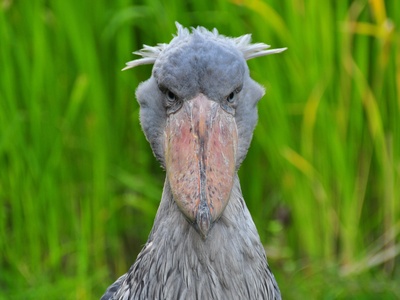
Shoebill
A massive, prehistoric-looking bird with a huge, shoe-shaped bill. It stands motionless for long periods while hunting lungfish in freshwater swamps. Its range just reaches the wetlands of southeastern Nigeria.
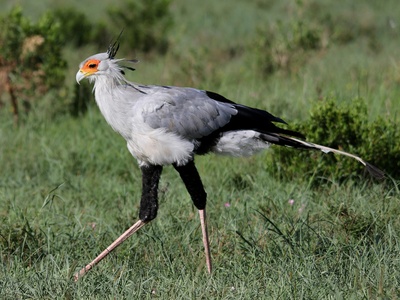
Secretarybird
A very large, terrestrial bird of prey that hunts snakes and other small animals on foot in open grasslands. It is famous for stomping its prey to death. Its long legs and crest of feathers resemble an old-fashioned secretary.
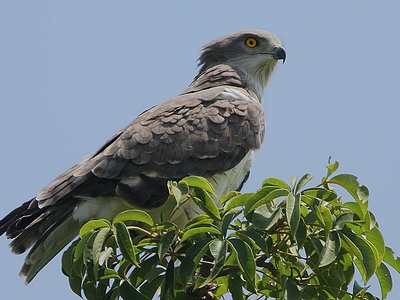
Beaudouin’s Snake Eagle
A large eagle of the Sahel and savanna regions that specializes in hunting snakes and other reptiles. It is threatened by habitat degradation from agriculture and urbanization. Often seen perching on prominent trees.
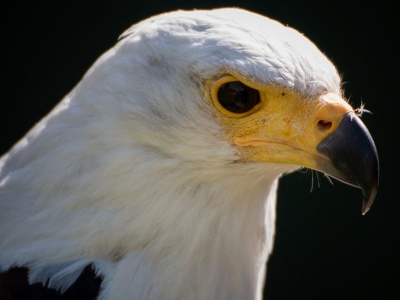
African Fish Eagle
A large eagle with a distinctive, haunting cry often called “the voice of Africa.” It has a white head and chest, a brown body, and powerful talons for catching fish from rivers and lakes across the continent.
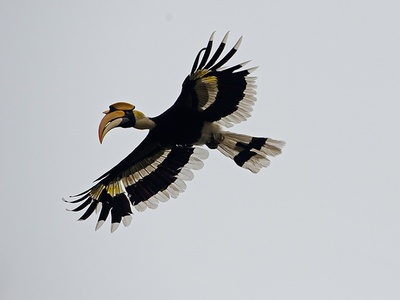
Yellow-casqued Hornbill
A very large black-and-white hornbill with a massive yellow casque on its bill. It lives in the canopy of lowland primary forests, feeding on fruits and insects. The loud ‘whoosh’ of its wingbeats is unmistakable.
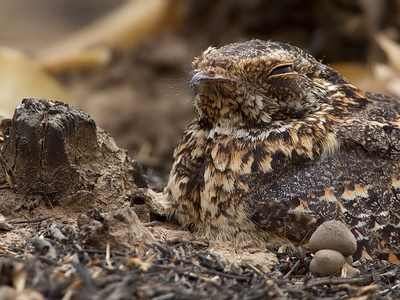
Standard-winged Nightjar
A nocturnal, insect-eating bird. During the breeding season, males grow two incredibly long, racket-tipped feathers from their wings, which are used in courtship displays at dusk.
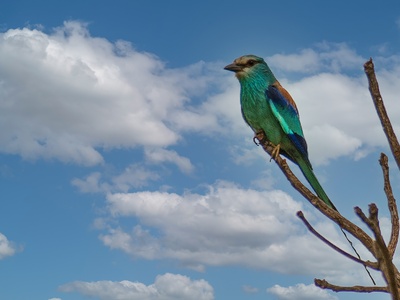
Abyssinian Roller
A brilliantly colored bird with a sky-blue body, dark blue wings, and a brown back. Often seen perched on wires or bare branches in savanna habitats, from which it swoops down to catch insects.
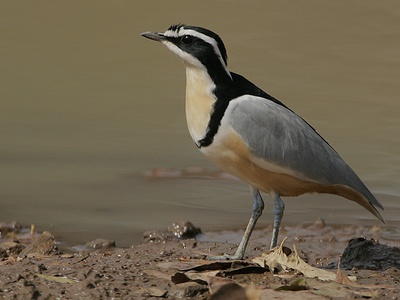
Egyptian Plover
Also known as the “crocodile bird” due to a myth that it cleans crocodiles’ teeth. It is a striking wader found along sandbanks of large tropical rivers, where it nests by burying its eggs in the warm sand.
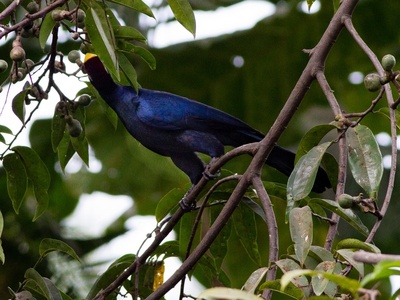
Violet Turaco
A stunning, large bird with glossy violet plumage and a bright yellow and red bill. When it flies, it reveals brilliant crimson wing patches. It is found in woodland and gallery forests, feeding on fruits.
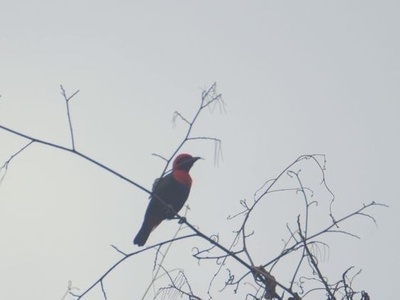
Ibadan Malimbe
A rare weaverbird species found only in a small, specific area around the city of Ibadan in southwestern Nigeria. It inhabits forest patches and secondary growth. This striking red-and-black bird is threatened by urbanization.
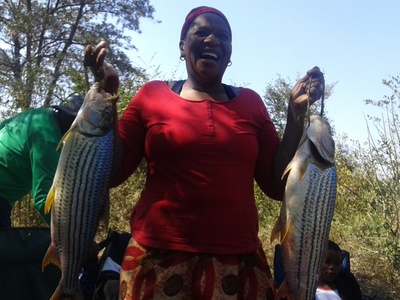
Goliath Tigerfish
A massive, ferocious-looking predatory fish with large, dagger-like teeth. It is a powerful swimmer found in large river systems. It is a legendary sport fish, known for its strength and aggressive nature.
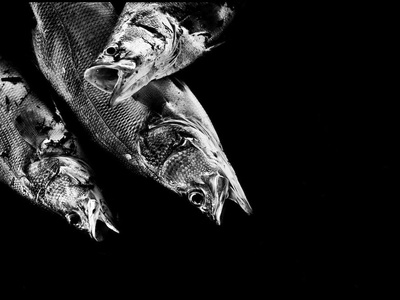
Nile Perch
A large freshwater fish that can reach up to 2 meters and 200 kg. Native to major river basins like the Niger and Senegal, it is a voracious predator that has also become a destructive invasive species in other parts of Africa.
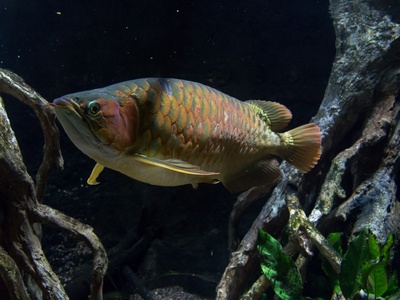
African Arowana
A large, primitive-looking freshwater fish found in calm waters like swamps and floodplains across the Sahel region. It is an air-breather and filter-feeder, consuming plankton. Valued as a food fish.
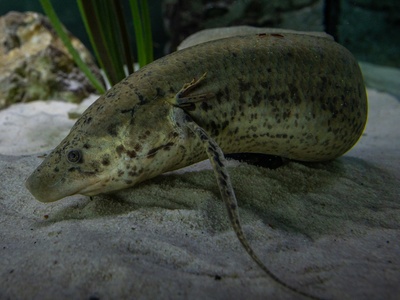
West African Lungfish
An amazing fish that can survive dry seasons by burrowing into the mud and forming a cocoon, breathing air via a modified swim bladder (lung). It can remain dormant for a year or more, waiting for the rains to return.
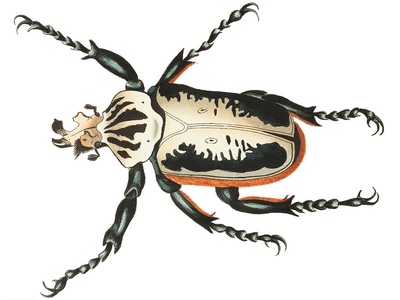
Goliath Beetle
One of the largest insects on Earth by weight and bulk. Males have a Y-shaped horn used for battling other males. Its larvae develop in rotting wood in tropical forests, and adults feed on tree sap and fruit.
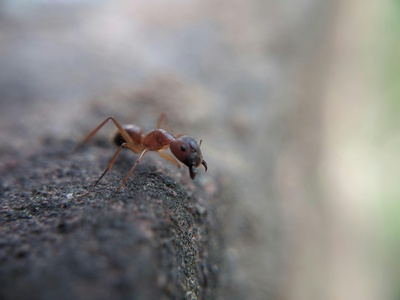
Driver Ants
Also known as siafu, these ants form massive nomadic colonies of up to 20 million individuals. They are voracious predators, moving across the forest floor in huge columns and consuming any small animal that cannot escape.
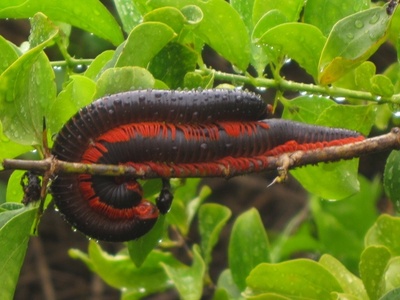
African Giant Millipede
One of the largest millipede species in the world, growing up to 38 cm long. They are harmless detritivores, feeding on decaying organic matter on the forest floor, and curl into a spiral for defense.
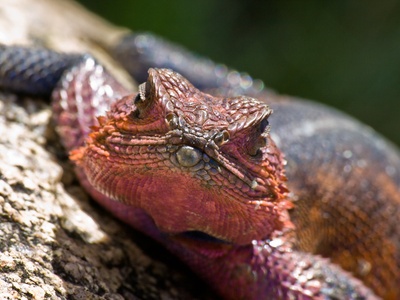
Common Agama Lizard
A common sight in many areas, often seen basking on rocks and walls. Breeding males are spectacularly colored with a bright orange or red head and a deep blue body. They live in social groups dominated by a single male.
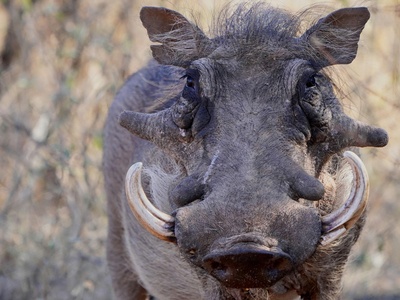
Warthog
A wild pig known for the prominent “warts” on its face and upward-curving tusks. Found in grassland and savanna, they are resilient animals that live in family groups and sleep in burrows.
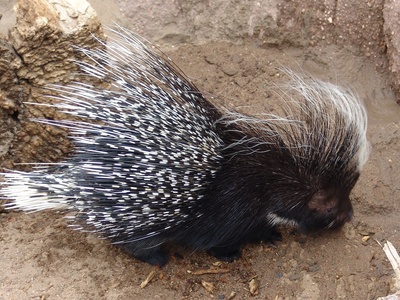
Crested Porcupine
A large rodent covered in long, black-and-white quills used for defense. When threatened, it raises its quills and charges backward to impale a predator. It is nocturnal and feeds on roots, bark, and fallen fruit.
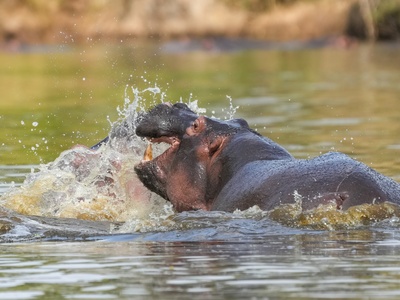
Hippopotamus
A large, semi-aquatic mammal, highly aggressive and responsible for more human deaths in Africa than any other large animal. They spend days in water to keep cool and emerge at night to graze.
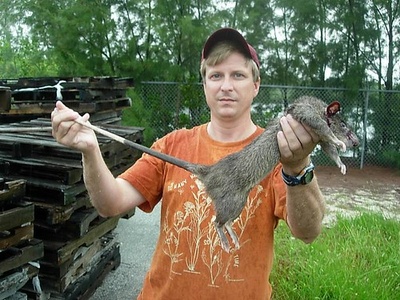
Gambian Pouched Rat
A very large nocturnal rodent, famous for being trained to detect landmines and tuberculosis due to its keen sense of smell. It has large cheek pouches for carrying food and is found in a wide variety of habitats.
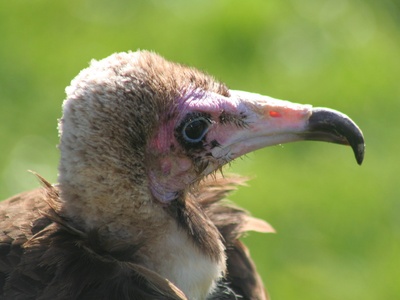
Hooded Vulture
A small vulture often found in or near human settlements, feeding on refuse and carcasses. Once common, its populations have collapsed due to poisoning, belief-based use, and habitat loss, making it critically endangered.
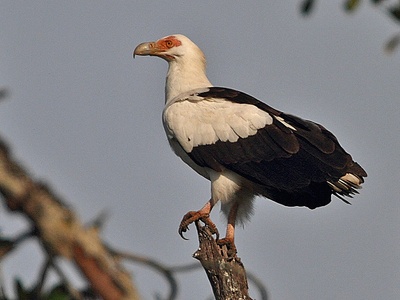
Palm-nut Vulture
A unique bird of prey whose diet primarily consists of the fruit of the oil palm, though it also eats fish and crabs. It is a black-and-white bird that resembles an eagle and is often found in coastal forests and mangroves.
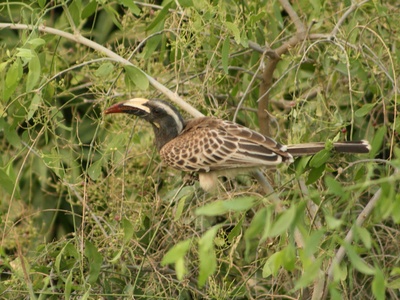
African Grey Hornbill
A common and widespread hornbill of savanna and woodland habitats. It is a medium-sized grey and white bird with a large, dark bill topped with a small casque. It has a distinctive, undulating flight pattern.
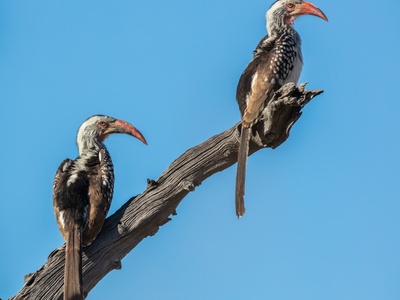
Red-billed Hornbill
A familiar hornbill of dry savanna habitats, recognized by its long, curved, bright red bill. They are often seen foraging on the ground for insects and small reptiles.
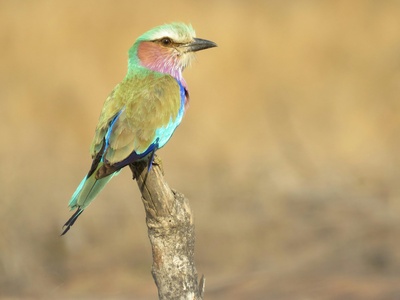
Lilac-breasted Roller
Often considered one of the world’s most beautiful birds, it has an incredible plumage of over eight colors, including a pastel lilac breast. It is an insectivore found in open woodland and savanna, often perching prominently.
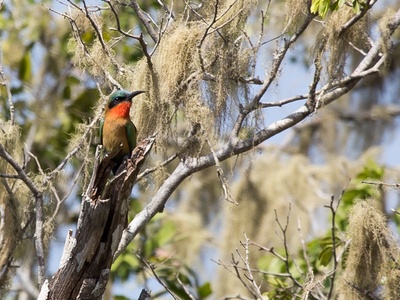
Red-throated Bee-eater
A brightly colored bird that nests in colonies in earthen banks along rivers. It has a green body, a bright red throat, and a black eye-mask. They are expert aerial hunters of bees and other flying insects.
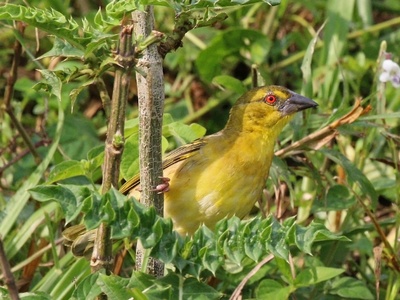
Village Weaver
A common and noisy bird known for building intricate, hanging nests from reeds or tree branches, often in large colonies near water or villages. Males are bright yellow with a black head.
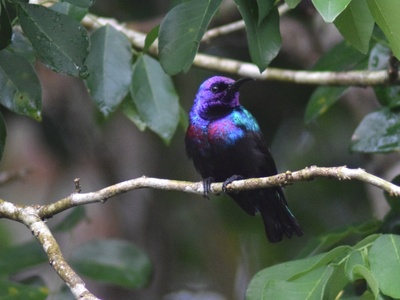
Splendid Sunbird
A jewel-like bird where the male has iridescent plumage that shifts from violet to green to black. They have a long, decurved bill for feeding on nectar from flowers in forests and gardens, much like a hummingbird.
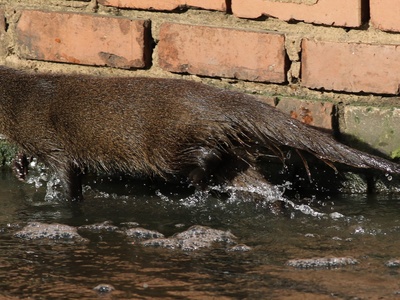
Marsh Mongoose
A medium-sized mongoose with a dark, shaggy coat, adapted for a semi-aquatic life. It hunts in and around water for crabs, frogs, and fish. It has strong claws for digging and breaking open shells.
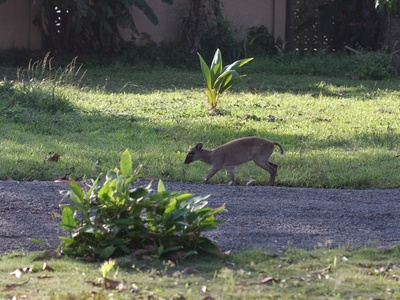
Maxwell’s Duiker
A small, shy antelope found in the forest undergrowth. It is a solitary browser, feeding on leaves, fruits, and flowers. Its small size and secretive nature allow it to move quietly through dense vegetation.
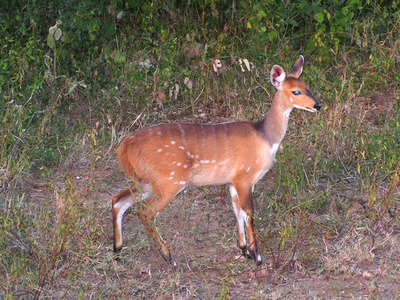
Bushbuck
A widespread and adaptable medium-sized antelope. Males have short, twisted horns. They are solitary browsers with a coat marked by white spots and stripes, providing camouflage in forest and thicket habitats.
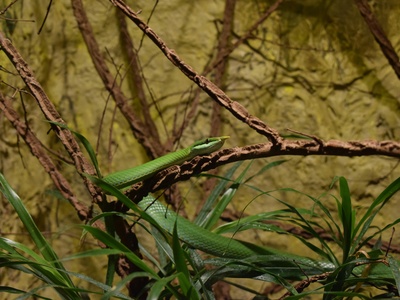
Green Bush Viper
A small, venomous, and beautifully colored arboreal snake. It has strongly keeled scales that give it a bristly appearance. It uses its prehensile tail to hang from branches while ambushing small prey in the rainforest.
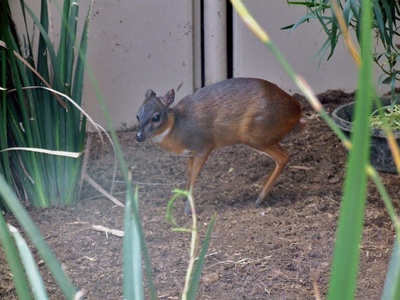
Royal Antelope
The world’s smallest antelope, standing only about 25 cm tall at the shoulder. This tiny, shy creature lives in the dense undergrowth of West African rainforests, making it very difficult to spot.
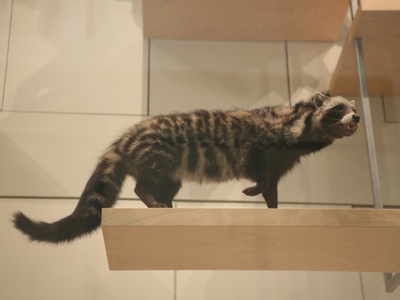
African Civet
A large, nocturnal mammal with a unique black-and-white coat and a stocky, dog-like build. It produces a strong-smelling musk from its perineal glands, historically used in perfumery. It is an omnivore found in forests and savannas.
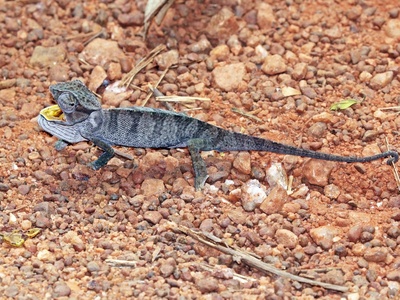
Senegal Chameleon
A common chameleon of West African savannas and woodlands. It is typically green or brown but can change color based on mood and temperature. It has a long, sticky tongue to catch insects from a distance.
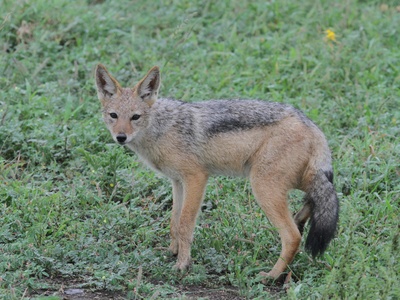
Striped Jackal
A medium-sized canid found in woodland and savanna habitats. It is more of an omnivore than other jackals, with a diet that includes a significant amount of fruit and insects alongside small animals.
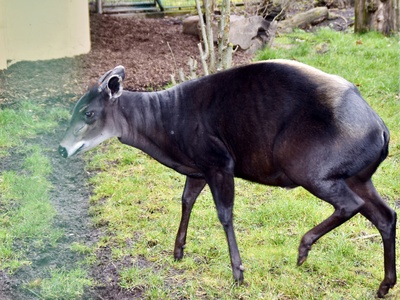
Yellow-backed Duiker
The largest of all duiker species, this forest antelope is named for the distinctive patch of yellowish hair on its rump, which bristles when it is alarmed. It is a shy browser found in dense rainforests.
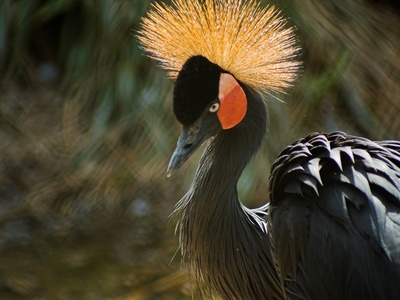
Black Crowned Crane
An elegant bird with a golden crown of stiff feathers, a velvety black head, and white and red cheek patches. It performs spectacular dancing displays during courtship and inhabits wetlands and grasslands of the Sahel.
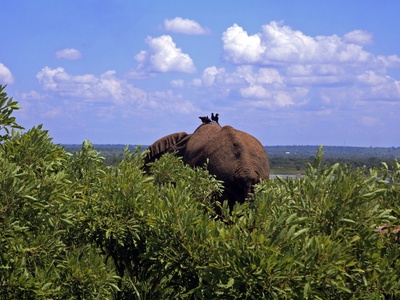
Piapiac
A glossy black member of the crow family with a long tail and a thick bill. Often found in social groups in savanna habitats, where it frequently associates with grazing livestock, perching on their backs to find insects.
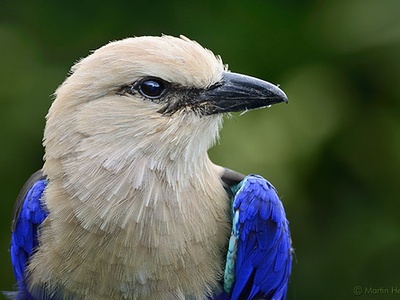
Blue-bellied Roller
A stunningly beautiful bird with a cream-colored head and chest, a dark back, and a brilliant ultramarine belly and tail. It is found in moist savanna and woodlands, often seen perching high in dead trees.
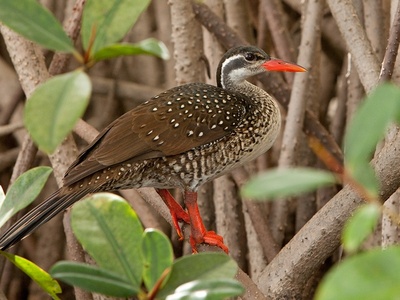
African Finfoot
A shy and elusive waterbird resembling a cross between a duck and a cormorant. It has a long neck, a sharp bill, and brightly colored lobed feet. It forages along wooded rivers and streams, swimming low in the water.
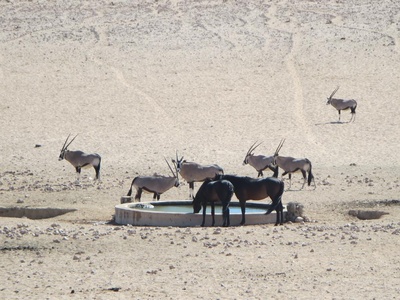
Gemsbok
A large, striking antelope with long, spear-like horns and distinctive black-and-white facial markings. Adapted to arid environments, it can survive without drinking water for long periods. Found in the semi-desert regions of the Sahel.
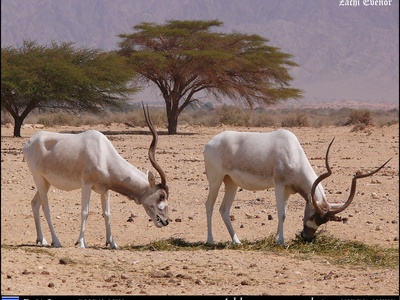
Addax
A desert-adapted antelope with long, twisted horns. It is critically endangered and on the verge of extinction in the wild, with only a tiny, precarious population remaining in the remote Sahara of Niger and Mauritania.
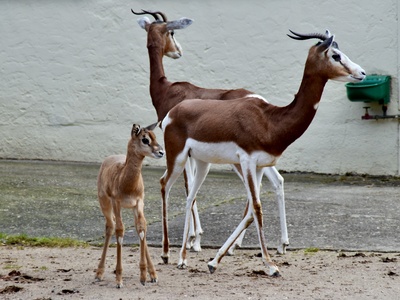
Dama Gazelle
One of the most endangered large mammals in the world. This pale gazelle is adapted to the harsh Sahara and Sahel, but its wild population has been decimated by uncontrolled hunting and habitat loss.
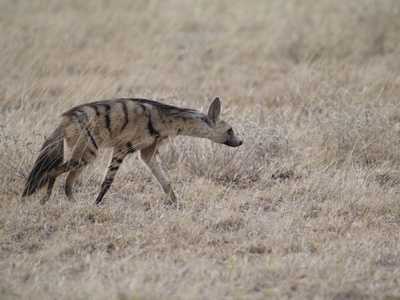
Aardwolf
A unique, insectivorous member of the hyena family. Despite its fearsome name, it does not hunt large prey but uses its long, sticky tongue to eat thousands of termites each night. It has a distinctive striped coat and a mane.
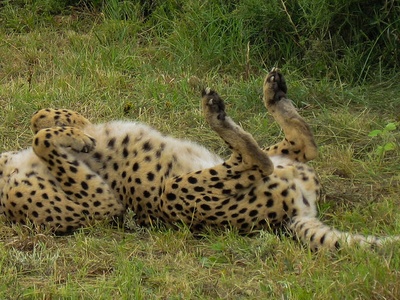
Cheetah
The world’s fastest land animal. The Northwest African cheetah subspecies is critically endangered, with a tiny, fragmented population surviving in the vast, arid landscapes of the Sahara and Sahel, including the W-Arly-Pendjari Complex.
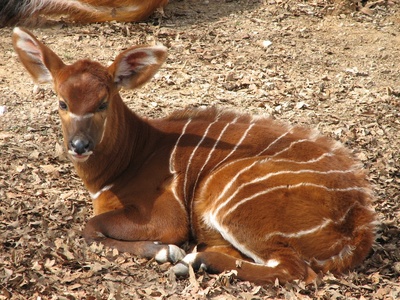
Bongo
A large, reclusive forest antelope with a striking reddish-brown coat marked with thin white vertical stripes, providing excellent camouflage. It is primarily nocturnal and browses on leaves and shrubs in dense rainforests.
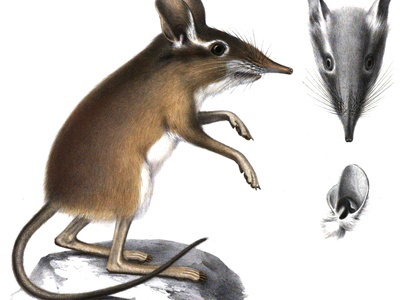
Four-toed Sengi
Also known as an elephant shrew, this small, insectivorous mammal has a long, flexible snout and long legs. Despite its appearance, it is more closely related to elephants than to shrews. It scurries through the forest floor like a tiny antelope.
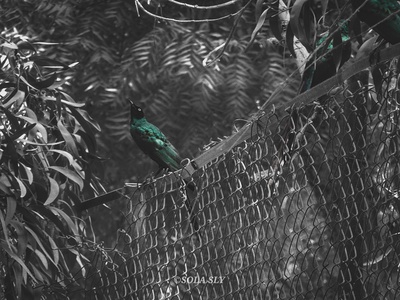
Long-tailed Glossy Starling
A spectacular bird with iridescent blue-green plumage and a very long, graduated tail. It is a common and noisy resident of savanna and open woodlands, often found foraging on the ground in flocks.
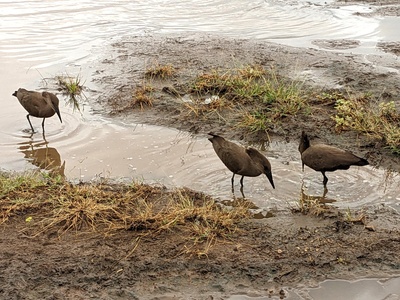
Hammerkop
A medium-sized wading bird named for its hammer-shaped head. It is known for building enormous, sturdy, dome-shaped stick nests, often more than 1.5 meters across, which are then used by other birds and animals.
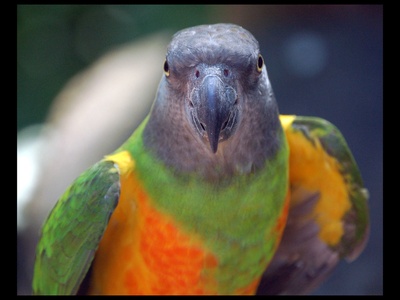
Senegal Parrot
A small, stocky parrot with a grey head, green back, and a yellow-to-orange belly. It is a popular pet due to its playful nature. In the wild, it inhabits open woodland and savanna, feeding on fruits and seeds.
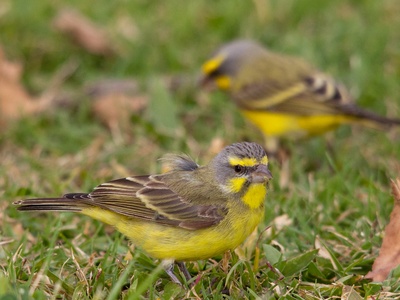
Yellow-fronted Canary
A small, common finch with a bright yellow underside and face, and an olive-green back. It has a cheerful, musical song and is often found in open woodlands, savannas, and gardens, feeding on seeds.
